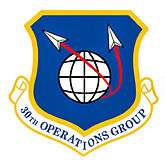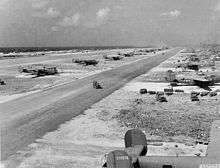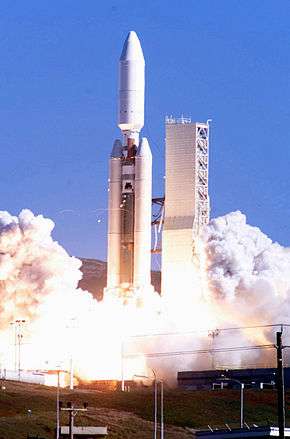30th Operations Group
| 30th Operations Group | |
|---|---|
|
Titan IVB launching Lacrosse satellite at Vandenberg AFB | |
| Country | United States |
| Branch | United States Air Force |
| Insignia | |
| 30th Operations Group emblem[1] |
 |
| 30th Bombardment Group emblem[2] |
 |
The 30th Operations Group (30 OG) is an operational component of the United States Air Force 30th Space Wing, stationed at Vandenberg Air Force Base, California.
The group provides the core capability for West Coast spacelift and range operations. Operations Group professionals are responsible for operating and maintaining the Western Range for spacelift, missile test launch, aeronautical and space surveillance missions.
Units
- 2d Range Operations Squadron (2nd ROPS)
- Controls and operates the Western Range for spacelift, ballistic missile test launch, aeronautical test, air defense exercise, missile defense test launch and space surveillance operations. The 2nd ROPS directs over 1,000 Air Force and contractor personnel at four geographically separated locations spanning more than 450 miles. The squadron ensures optimum conVguration and performance of tracking, telemetry, communications, data analysis and meteorological assets valued at over $1.5 billion.
- 30th Operations Support Squadron (30th OSS)
- The squadron leads the wing spacelift operations training program, operates a $3.5 billion airVeld complex, develops weapon system tactics for the 30th OG and provides intelligence services for the wing and tenant units. The 30th OSS operates the Air Force's only space Training Device Design and Engineering Center, producing most of the space and missile training devices used throughout AFSPC and Air Education and Training Command.
- 30th Space Communications Squadron (30th SCS)
- Is a key partner in the successful launching of satellites for combatant commanders' requirements and other test range activities. The squadron is focused on the operation and maintenance of the Western Range network segment enabling Wight test, spacelift and ballistic missions. The 30th SCS manages the budget for optical tracking, land mobile radio, airVeld systems, RF spectrum management, missile silo communications, base secure and non-secure voice/video/data network operations, network defense, computer systems support, personal wireless communications systems, base-level services, information management, small computers, visual information and communications security for AFSPC, the 14th Air Force, 30th SW, Western Range and tenant units. Additionally, the 30th SCS provides support for telephone services and infrastructure management/upgrades.
- 30th Range Management Squadron (30th RMS)
- Manages day-to-day contractor operations and maintenance of the range, launch complexes and payload facilities. The unit provides acquisition program management and quality assurance expertise on all 30th SW and Space and Missile Systems Center (SMC) mission support contracts and space programs. Additionally, the 30th RMS provides technical requirements development, systems integration, operational acceptance testing and sustainment services for 30th SW range systems. The squadron interfaces with SMC for all range sustainment, integration and development efforts.
- 30th Weather Flight (30th WF)
- Provides 30th Space Wing and tenant units a full range of weather services supporting launch, air and ground operations. Major services include daily weather forecasting, toxic hazard zone forecasting, surface and upper-air observing, technical support and around-the-clock resource protection from severe weather. The 30th WS provides planning and day-of-launch on-console weather support to the Western Range Control Center for all Western Range launch operations.
History

- For additional history and lineage, see 30th Space Wing
Patrolled west coast, 1942–1943, while training crews for other units.
Began operations in the Pacific in November 1943. Attacked enemy installations on the Gilbert Islands in support of U.S. invasion; raided enemy airfields in the Marshalls to prevent Japanese airplanes launching against Tarawa. From January–March 1944, bombed installations in the Marshalls in preparation for their occupation. During April–Jul, raided airfields and navy facilities in the Truk Islands to keep them neutralized during the U.S. attack on the Marianas; also bombed Wake, Guam, and Saipan. From August 1944 until the U.S. took Iwo Jima in early 1945, the group attacked airfields and shipping in the Bonin and Volcano Islands and hit bypassed islands in the Carolines and Marianas until March 1945, when group returned to Hawaii for routine patrols and training until inactivated.
Search, rescue, and recovery missions in area of Vandenberg AFB, CA, 1993–. Launched meteorological and surveillance satellites into polar earth orbit, 1990–. Launched first interceptor missile in Ground-based Midcourse Defense (GMD) program, September 2006. Deployed airmen worldwide to meet national commitments, 2005–.
Lineage
- Established as 30th Bombardment Group (Heavy) on 20 November 1940
- Activated on 15 January 1941
- Redesignated as: 30th Bombardment Group, Heavy, on 20 August 1943
- Inactivated on 25 June 1946
- Redesignated 30th Operations Group on 1 November 1991
- Activated on 19 November 1991.
Assignments
|
|
Components
- 2d Space Launch Squadron: 19 November 1991 – 1 December 2003
- 4th Space Launch Squadron: 15 April 1994 – 29 June 1998
- 2d Reconnaissance Squadron (Heavy) (later 392d Bombardment Squadron) attached 15 January 1941 – 21 April 1942, assigned 22 April 1942 – 30 November 1945
- 21st Bombardment Squadron: 15 January 1941 – 1 November 1943 (detached, 9 January 1942 – September 1943)
- 27th Bombardment Squadron: 15 January 1941 – 20 March 1946
- 38th Bombardment Squadron: 15 January 1941 – 20 March 1946
- 819th Bombardment Squadron: 11 October 1943 – 30 November 1945
Stations
|
|
Aircraft and Missiles
|
|
References
![]() This article incorporates public domain material from the Air Force Historical Research Agency website http://www.afhra.af.mil/.
This article incorporates public domain material from the Air Force Historical Research Agency website http://www.afhra.af.mil/.
- Maurer, Maurer (1983). Air Force Combat Units Of World War II. Maxwell AFB, Alabama: Office of Air Force History. ISBN 0-89201-092-4.
- Vandenberg AFB factsheet, 30th Operations Group


.svg.png)
.svg.png)
.svg.png)